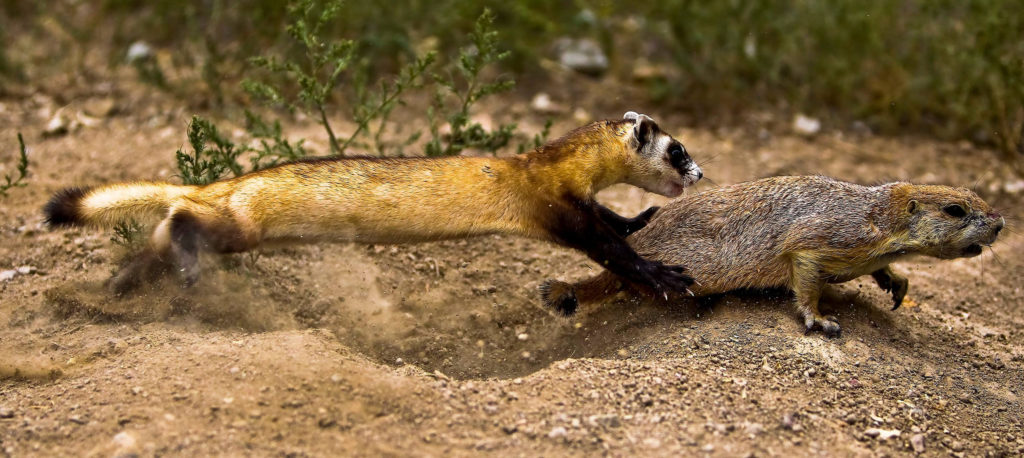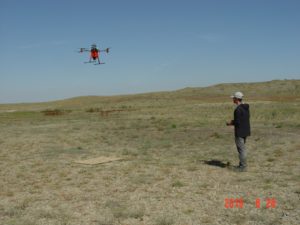
The US Fish and Wildlife Service is adapting new technology to the business of saving and endangered species: they’re sending in the drones.

Black-footed ferrets are a small, solitary, extremely territorial weasel-like animal that lives in the American west. Once abundant in central North America, today, their wild population stands at around 500. Black-footed ferrets were decimated by sylvatic plague (a close relative of the bubonic plague), as well as habitat loss and an early eradication campaign.
Black-footed ferret numbers were so severely depleted that, in 1979, after a failed captive-breeding program, they were considered extinct. A decade later, one remnant ferret colony was discovered. Conservationists debated allowing that population to remain wild—after all, it had survived so far on its own—or use it to establish a captive breeding program. For a while, the consensus was to let them live free, but then the plague came.
Sylvatic plague delivers a one-two punch to the black-footed ferret. The wiry hunter is susceptible to this fatal infection, and so is its food source. Black-footed ferrets survive almost exclusively on prairie dogs, which are also extremely susceptible to sylvatic plague. With up to a 100 percent mortality rate, the plague can wipe out entire prairie dog populations in a season. Their only food source exterminated, the black-footed ferrets starve.
And that’s the rub. There is an effective vaccine for both prairie dogs and black-footed ferrets, but effective vaccination campaigns require establishing herd immunity (immunizing a critical mass of prairie dogs to minimize spreading the plague). With such small populations, it’s not particularly difficult to trap and vaccinate the ferrets, but the prairie dogs are a much bigger challenge.

The drone in question is a hefty 8-bladed octocopter designed to aid in the protection of the rare black-footed ferret, via a new program led by Randy Matchett of the US Fish and Wildlife Service. The octocopter carries a dispenser that shoots vaccine pellets out 30-feet on either side of the aircraft. Soaring over the prairie dogs’ habitat, the drone can cover the entire area faster and more efficiently than ground-based solutions. A pilot and observer supplement the semi-autonomous system, ensuring safety and comprehensive coverage.
The vaccine is an unassuming pellet, an oral dose mixed with peanut butter to attract prairie dogs. The prairie dogs love them, but the ferrets only have eyes (and teeth) for the prairie dogs. Vaccinating the black-footed ferret still requires footwork, but with such a small wild population, that task is now greatly simplified. All captive-bred ferrets are vaccinated before release and any wild ferrets are vaccinated during capture-based surveys.
Getting a drone like this off the ground requires the commitment of many public and private partners. “This is one of those once-in-a-lifetime projects where endangered species conservation, technology, and a passionate group of partners all align for a common goal,” said Ryan Moehring of the US Fish and Wildlife Service Public Affairs Office.
Comprehensive vaccination programs have been tried, with mixed success. One ferret needs 50 to 100 acres of prairie dog habitat to survive, so the areas that need to be covered are huge. The US Fish and Wildlife Service has attempted some ground-based delivery systems. ATVs loaded with vaccine-laced-pellet dispensers can’t effectively cover the area needed to effectively vaccinate enough prairie dogs and is destructive to the prairie ecosystem. They have also tried spraying prairie dog burrows with a dust to kills the fleas that carry the plague, which also doesn’t provide comprehensive coverage and, according to Moehring, the fleas are becoming resistant to the dust. Both options are extremely labor intensive.
The plague-busting, prairie-dog-vaccinating, ferret-saving drone made waves earlier this summer when the project was opened up for public comment. People get nervous when drones are flying overhead, and doubly so when it’s the government flying them, which makes public engagement and community outreach essential to the success of this project. While a few public comments raised the conventional complaints about use of taxpayer money or necessity for any conservation effort, few were directed specifically at the use of drones. (One argued that “UASs disturb the natural serenity of wild landscapes” while simultaneously promoting the continued use of a fleet of off-road vehicles.) According to Matchett, “comments were mostly supportive.”
Since the public comment period closed, Matchett and his team have made major strides, with test flights well under way. Initial trials revealed some jamming issues with the pellet dispenser and problems with flight path planning, both of which have been successfully corrected. There’s already a path forward for future development, with plans to adapt the dispenser to spread multiple pellets over a wider area, tripling the drone’s efficiency on each pass.
According to Moehring, “while we still are far from having a knockout punch for plague, the fact that we have these outstanding partners at the table and have access to this cutting edge technology is incredibly encouraging.” That’s good news for the black-footed ferret.
Hey Team Ocean! Southern Fried Science is entirely supported by contributions from our readers. Head over to Patreon to help keep our servers running and fund new and novel ocean outreach projects. Even a dollar or two a month will go a long way towards keeping our website online and producing the high-quality marine science and conservation content you love.